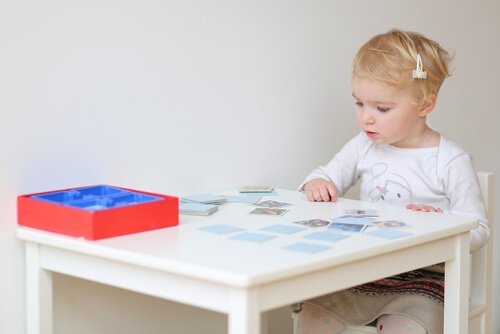How to Improve Children's Visual Memory

Finding ways to improve visual memory in children is an issue that concerns many parents. Keep in mind that when your child turns one year old, you can start stimulating his or her memory.
Visual memory is very beneficial, as it significantly helps children develop cognitive and comprehension skills. The role of language in labeling and understanding images is also important.
Likewise, through visual memory, you can identify and produce colors, shapes, symbols, letters, words and sentences. In the same way, you remember recent visual experiences.
You can divide visual memory into two parts: long term and short term. Long term is the ability to remember seeing something in the past, whereas short term is the ability to remember something you saw recently.
Benefits of visual memory for school performance
Visual memory plays a key role in children’s overall development. It helps them with the skills they need to succeed in school.
In some cases, you may notice poor spelling, low speed, reading comprehension issues and difficulty copying or memorizing texts.
In fact, these can hide problems with perception and visual memory. Visual memory helps certain children with learning difficulties improve their school performance.
“Don’t prevent your children from the difficulties of life. Instead, teach them to overcome them.”
–Louis Pasteur–
Consequences of poor visual memory
A child with poor visual memory may experience difficulty with the following skills and activities:
- Identifying and memorizing letters and other common symbols
- Spelling unfamiliar and irregular words
- Reading comprehension
- Not identifying symbols when using a calculator
- Memorizing telephone numbers
- Will suffer greater distractions

How to improve visual memory in children
Here, we’ll show you 4 tips to improve visual memory in children:
1. Games
Through games, children can enhance their intellectual skills. Games can be very helpful because children will learn while having fun.
Here are some games to improve children’s visual memory:
- Chained words
You should start by saying one word. Then, the child should say a word that starts with the last syllable of the previous one.
- Recognize songs
Through music, you can play to see who recognizes the song first.
- Tongue twisters
Word games are a great way to enhance auditory memory. The mother must say a tongue twister, and the child repeats it.
- Repeating a series of numbers or letters
Children and parents should repeat a series of numbers and letters. You can write them down, and they can recite them without reading them.
2. Making up stories
Start with a story like, “Once there was an 8-year-old girl who enjoyed playing outside.” Then, the child should add sentences.
You should ask your child to remember what each player adds to the story. Each of you needs to retell the story from the beginning at each turn before adding a new line.
3. Observation and reflection
It’s important to observe and reflect. When you go on a family outing, take the time to observe something. Then, discuss it in lots of detail with your child. For example, you can go to an art gallery, a park, or a pretty neighborhood.
Later, have your child describe everything he can. Pay attention to the colors and contrasts, the shapes, and even the small details.

4. Information
Lists of instructions or a page full of words and images can be confusing. A well-structured document can help your child easily choose the most important information. Consequently, he can remember it better.
Finally, it’s important to emphasize that practice affects memory development. The more opportunities that children have to train their memory capacity, the better their memory will be in the future.
Therefore, it’s a good idea to start practicing as soon as possible to build this important life skill. As you’ll see, it will have a positive effect on many skills that children use at school and in everyday life.
Finding ways to improve visual memory in children is an issue that concerns many parents. Keep in mind that when your child turns one year old, you can start stimulating his or her memory.
Visual memory is very beneficial, as it significantly helps children develop cognitive and comprehension skills. The role of language in labeling and understanding images is also important.
Likewise, through visual memory, you can identify and produce colors, shapes, symbols, letters, words and sentences. In the same way, you remember recent visual experiences.
You can divide visual memory into two parts: long term and short term. Long term is the ability to remember seeing something in the past, whereas short term is the ability to remember something you saw recently.
Benefits of visual memory for school performance
Visual memory plays a key role in children’s overall development. It helps them with the skills they need to succeed in school.
In some cases, you may notice poor spelling, low speed, reading comprehension issues and difficulty copying or memorizing texts.
In fact, these can hide problems with perception and visual memory. Visual memory helps certain children with learning difficulties improve their school performance.
“Don’t prevent your children from the difficulties of life. Instead, teach them to overcome them.”
–Louis Pasteur–
Consequences of poor visual memory
A child with poor visual memory may experience difficulty with the following skills and activities:
- Identifying and memorizing letters and other common symbols
- Spelling unfamiliar and irregular words
- Reading comprehension
- Not identifying symbols when using a calculator
- Memorizing telephone numbers
- Will suffer greater distractions

How to improve visual memory in children
Here, we’ll show you 4 tips to improve visual memory in children:
1. Games
Through games, children can enhance their intellectual skills. Games can be very helpful because children will learn while having fun.
Here are some games to improve children’s visual memory:
- Chained words
You should start by saying one word. Then, the child should say a word that starts with the last syllable of the previous one.
- Recognize songs
Through music, you can play to see who recognizes the song first.
- Tongue twisters
Word games are a great way to enhance auditory memory. The mother must say a tongue twister, and the child repeats it.
- Repeating a series of numbers or letters
Children and parents should repeat a series of numbers and letters. You can write them down, and they can recite them without reading them.
2. Making up stories
Start with a story like, “Once there was an 8-year-old girl who enjoyed playing outside.” Then, the child should add sentences.
You should ask your child to remember what each player adds to the story. Each of you needs to retell the story from the beginning at each turn before adding a new line.
3. Observation and reflection
It’s important to observe and reflect. When you go on a family outing, take the time to observe something. Then, discuss it in lots of detail with your child. For example, you can go to an art gallery, a park, or a pretty neighborhood.
Later, have your child describe everything he can. Pay attention to the colors and contrasts, the shapes, and even the small details.

4. Information
Lists of instructions or a page full of words and images can be confusing. A well-structured document can help your child easily choose the most important information. Consequently, he can remember it better.
Finally, it’s important to emphasize that practice affects memory development. The more opportunities that children have to train their memory capacity, the better their memory will be in the future.
Therefore, it’s a good idea to start practicing as soon as possible to build this important life skill. As you’ll see, it will have a positive effect on many skills that children use at school and in everyday life.
All cited sources were thoroughly reviewed by our team to ensure their quality, reliability, currency, and validity. The bibliography of this article was considered reliable and of academic or scientific accuracy.
- Barreno Freire, N. C. (2013). Los bits de inteligencia y su influencia en el desarrollo de la memoria visual-auditiva de los niños y niñas del primer ciclo de la escuela república de alemania del cantón mocha, provincia de tungurahua (Bachelor’s thesis). https://repositorio.uta.edu.ec/handle/123456789/4083
- Ramos Bejarano, M. P. (2018). Las técnicas lúdicas y su influencia en el desarrollo de la memoria visual en los niños de 2 a 3 años del Centro Infantil del Buen Vivir Gotitas De Amor de San Antonio de Ibarra, provincia de Imbabura en el año lectivo 2014-2015 (Bachelor’s thesis). http://repositorio.utn.edu.ec/handle/123456789/8429
- Prada, J. L. M., & Díez, N. M. (2002). Análisis de una experiencia sobre el desarrollo de la memoria visual de los niños. Arte, individuo y sociedad, (1), 427-432. https://core.ac.uk/download/pdf/38827732.pdf
- Pino, M., & Bravo, L. (2005). La memoria visual como predictor del aprendizaje de la lectura. Psykhe (Santiago), 14(1), 47-53. https://scielo.conicyt.cl/scielo.php?pid=S0718-22282005000100004&script=sci_arttext&tlng=en
This text is provided for informational purposes only and does not replace consultation with a professional. If in doubt, consult your specialist.








